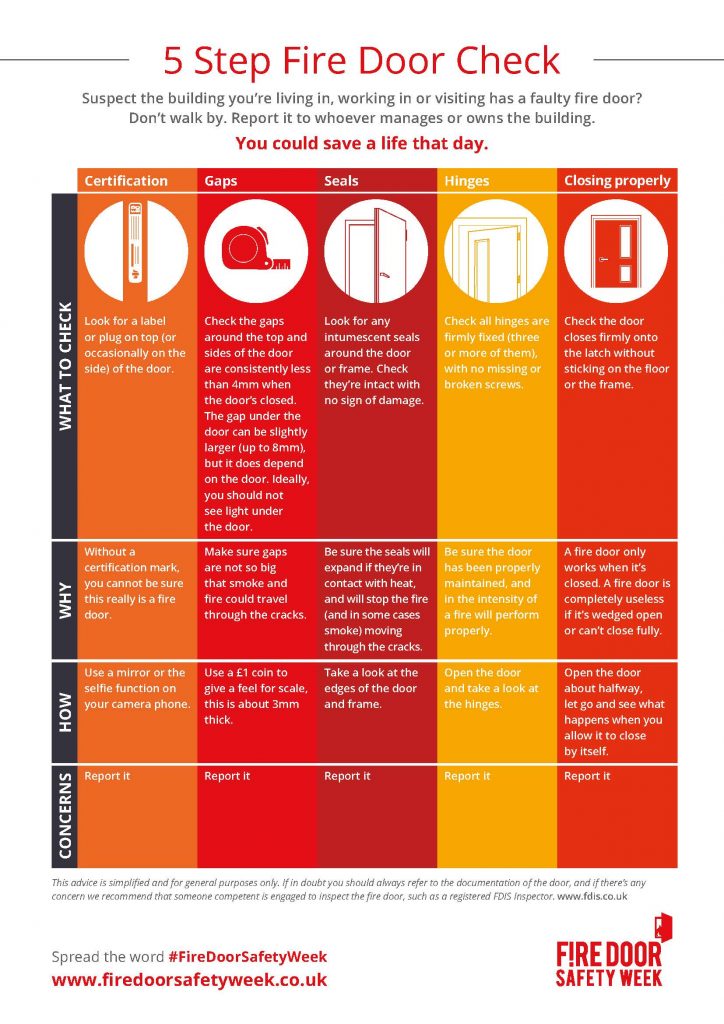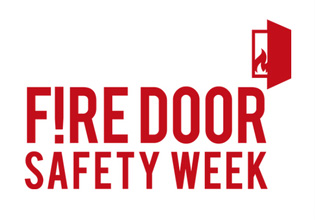Fire door campaign looks to reach new heights
Fire door campaign looks to reach new heights
Promoting awareness of the critical role of fire doors in high rise buildings, houses of multiple occupancy and other types of shared accommodation will be the focus of this year’s Fire Door Safety Week.
The annual national fire door awareness campaign is in its fifth year and is organised by the British Woodworking Federation (BWF), the BWF-Certifire Fire Door Scheme and the Fire Door Inspection Scheme (FDIS).
Fire Door Safety Week will take place from 25 September until 1 October 2017 and aims to raise awareness about the importance of fire doors in saving lives and protecting property, and the legal responsibilities of managing fire door safety.
Hannah Mansell, BWF Technical Manager, Fire Door Safety Week spokesperson and chair of the Passive Fire Protection Forum, said:
“In the wake of the Grenfell Tower devastation, it is right that once again our campaign focuses on assisting those who live in social housing, houses of multiple occupancy and other shared accommodation, and those whose job it is to keep them safe.
“For tenants and their landlords, Fire Door Safety Week is an important source of knowledge and education. The Fire Door Safety Week website has many free resources to help people understand the importance of fire doors, what good fire doors should look like and where to report any concerns to.”
The organisers of Fire Door Safety Week are also campaigning for a publicly available register of Responsible Persons to increase accountability following the Grenfell Tower fire.
The register would name individuals who carry the legal responsibility for fire safety in the buildings they own and manage and would provide a vital signpost to help residents report their concerns
Hannah Mansell, continued:
“For most of us, the Responsible Person is a mystery person. When the Regulatory Reform (Fire Safety) Order took effect over 10 years ago, all building owners, employers, landlords, head teachers, hotel managers, estates managers and many other people took on the legal responsibility for fire safety. As part of this, they are required to appoint a Responsible Person for each building they own or manage.
“Under the Fire Safety Order, the Responsible Person has to ensure that an annual fire risk assessment is carried out and in most cases, documented. The risk assessment has to demonstrate that adequate attention has been paid to all aspects of fire safety management, including active and passive fire measures, signage, means of escape and evacuation procedures. Where in-depth knowledge is lacking, the Responsible Person has a duty to engage someone with the relevant expertise to be able to implement or advise on key areas.
“There needs to be much greater visibility of the Responsible Person, in the same way that a first aider is legally required to be named on health and safety posters in many workplaces.
“By identifying the Responsible Person by name and providing the appropriate contact details, residents and building users are empowered to raise problems. This also ensures that those responsible for keeping them safe are made aware of issues directly.”
The call for a register of Responsible Persons was first made following the inquest into the death of Sophie Rosser, 23. Sophie died in a fire in a block of flats in Canary Wharf in 2012. At her inquest, the coroner could not identify who was accountable for her death because of confusion about who the Responsible Person for the building was.
Research last year confirmed the BWF’s fears that little has been done to address this problem. More than half of all tenants had no idea who the Responsible Person is for the building where they lived and even more worryingly, 15% of all tenants living in blocks of flats who have got fire safety concerns have never reported those concerns to anyone at all.
Under the Fire Safety Order, the responsibility for maintaining fire safety in non-domestic buildings falls to the Responsible Person.
By law the Responsible Person must ensure that a fire safety risk assessment is carried out. They must also implement and maintain a fire management plan. Part of the risk assessment and fire management plan must consider the safe installation, maintenance and inspection of fire doors.
The person responsible for fire safety in Scotland is called the ‘duty holder’, while in Northern Ireland they are known as the ‘appropriate person’. However, the duties of this person, regardless of country, are the same: to carry out the fire risk assessment and ensure the safety of anyone using their premises.
David Oldfield, BWF-Certifire chairman, commented:“Fire doors are in every building that we live in, work in and sleep in, but they are often overlooked, ignored and allowed to slip into a sorry state.
“Many people do not realise that the real job of a fire door is to hold back fire, smoke and toxic gases, delaying the spread around a building and keeping the vital means of escape route clear. They only work properly if they are specified, manufactured, installed and maintained correctly, and of course, closed when a fire breaks out.”
There are many ways to get involved with the campaign this year, including promoting the message of Fire Door Safety Week on websites and social media, running events and using the 5 Step Check to ensure that the fire doors where you live and work are in good condition.

It has already received support from a number of organisations and has confirmed events by London Fire Brigade, Children’s Burns Trust, ASSA ABLOY, Arnold Laver and BWF-Certifire.
The campaign is open to everyone, including individuals as well as organisations.
Find out more about Fire Door Safety Week and how to get involved at: http://firedoorsafetyweek.co.uk/
Published July 2017

